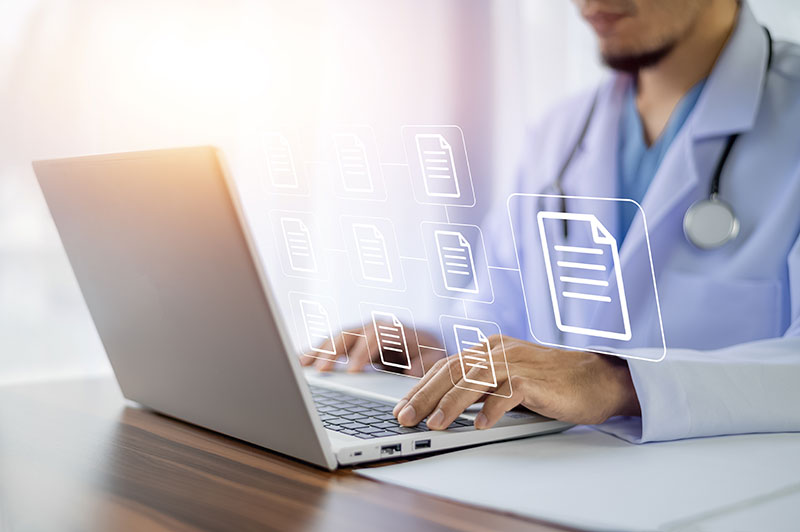With exciting advancements in the technology arena, the nature of work itself is changing for knowledge workers. New technologies such as telepresence are making telecommuting more feasible. Technology has impacted medical transcription just as it has other industries. Today’s medical transcriptionist represents a growing section of the U.S. workforce typified by a technology-enabled, knowledge worker employed from home. Medical transcription is becoming increasingly popular as a work-from-home profession. In fact, a fair number of medical transcription jobs are telecommuting positions obtained through an independent contractor arrangement. The convenience of working at home and flexible working hours make the job highly appealing for workers moving to home-based transcription.
Many medical transcriptionists (MTs) choose to be independent contractors or subcontractors, thereby performing the work from home, others work in doctors’ offices, hospitals, medical transcription businesses and rehabilitation centers. The clinician or medical facility supplies the dictation and the independent contractor transcribes the material, working conveniently from home.
An article in Forbes.com refers to the finding of Telework Research Network that one in five Americans work from home. Medical transcriptionists are always in high demand because many physicians are used to dictating their notes and would like to continue doing so. This will in turn naturally increase the demand for transcriptionists.
Crowdsourcing is yet another reason for the increase in home-based transcription jobs. Crowdsourcing has created a wider base of transcriptionists, where they are easily trained at home via online courses and thereby perform the work on a more cost-effective basis.
More and more transcription companies are also allowing their experienced MTs to work from home. Latest technologies such as Cisco Telepresence and Skype make it possible for employers to stay connected with their employees and access them anywhere in the world. With these advancements, location is no longer a barrier for successful completion of a job. With independent contractors, companies save on overhead operating costs as well as taxes.
Electronic medical records and speech-recognition software have changed the landscape of healthcare. Voice recognition software can automate and reduce the time required to transform medical dictation into medical transcription. Dragon Medical 360/ Network Edition 2.0 is the latest version of voice recognition software for medical professionals.
No matter how sophisticated the software, trained transcriptionists are still in demand especially in documenting complex information on procedures and medications that enter the market daily.
However, speech recognition technology has made the job easier for medical transcriptionists. Unlike in the traditional transcription method, they don’t have to type each and every word listening to the dictation. Now they just have to edit the documents, which is less time consuming. Dragon Medical 360 is offering up to 98 percent or higher accuracy out of the box, with no voice training needed. With this latest version, clinicians also experienced 20% fewer errors than the previous version.
The Other Side of the Coin
With all the advantages, individual home-based medical transcription may have its own disadvantages.
- Security issues: Probably, the major problem with working from home is lack in health information security. The documents the physician or a contracting company provides for transcription may include discharge summaries, history and physical examination reports, operating room reports, consultation reports, autopsy reports, diagnostic imaging studies and referral letters. Secure file servers are crucial to stay compliant with HIPAA guidelines. HIPAA requires all patient information to be kept confidential unless a release is signed, so you will have to have a secure connection to prevent data theft. A reliable medical transcription company implements the best security systems and has always adopted elaborate security measures to ensure that patient information is not compromised in any manner. They also use “encryption” to send/receive medical records through e-mail. Encryption is a process that uses special encryption software to protect the medical records during transfer
- Technical issues: Similar to any other technology-based job, medical transcription is also vulnerable to various technical issues such as server failures, breakdown in communications or software errors. Such technical difficulties cannot in many cases be corrected without assistance from a system admin or a technical support desk.
- Missing the general trend in the industry: As individual home-based jobs lack oral communication at job between colleagues, chances are more to miss the current trends in the industry. To stay competitive, it is crucial to stay abreast with the updates in the field.
- Backup action plans: To meet the turnaround time obligations, MTs should have a backup plan of the entire operations – such as a fully loaded second computer, a foot pedal, a headphone, a broadband connection and a power backup. All these increase the infrastructure cost, and home-based workers may find it quite challenging to implement all this.
Physicians and healthcare facilities can rely on medical transcription companies experienced in providing customized medical transcription service according to client requirements. The major advantage is that reputable firms will have a professional transcription team that is provided periodic training to stay updated with industry requirements. They will ensure that all data entrusted remains confidential by adhering to HIPAA norms. Healthcare providers also benefit from the service of a dedicated team assigned particularly to them to meet individual specialty and turnaround time requirements.


